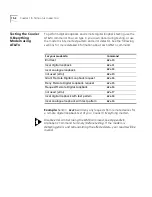
16-2
C
HAPTER
16: D
EDICATED
/L
EASED
L
INE
AND
SYNCHRONOUS
APPLICATIONS
Requirements
The information below describes device requirements.
Find out what hardware and software you need before proceeding.
A Device with a
Synchronous Serial
Port
You will probably have to purchase and install a synchronous adapter
card. These cards provide:
■
A synchronous serial port
■
Support for one or more synchronous protocols.
■
Additional software functions. For example, the card may tell the
mainframe what type of computer or terminal you are using. The card
may also tell the mainframe what resources you want to use.
A Serial Cable
Obtain a shielded serial cable with a male DB-25 connector on one end
and a connector on the other end that is appropriate for your
synchronous serial port. Your modem provides an EIA-232 interface
through its serial port.
Transmit and Receive synchronous timing pins are required at the EIA-232
interface, so pins 15 and 17 are required. The modem transmits timing
signals through pin 15 and receives timing signals through pin 17
Note: The serial cable included with your modem only supports
asynchronous mode.
Communications
Softwar
The devices at both ends of the link must use the same synchronous
protocol.
Ask your network administrator about the software support (for example
a specific communications package) that you need to log into the
network.
Synchronous
Operations
During synchronous operations, transmit and receive clocks at both ends
of the phone link control the precise timing of the data flow. The
communications equipment at the remote device, your modem and
computer must all handle the data at the same speed.
Your modem is usually the source of the transmit clock timing signals and
sends them to your computer over the EIA-232 interface. Your
computer’s rate will follow the connection rates.
Summary of Contents for Courier
Page 12: ......
Page 28: ...1 14 CHAPTER 1 CONNECTING TO YOUR ISP ...
Page 36: ...3 4 CHAPTER 3 UPGRADING YOUR MODEM ...
Page 58: ...6 6 CHAPTER 6 WORKING WITH MEMORY ...
Page 64: ...8 4 CHAPTER 8 CONTROLLING EIA 232 SIGNALING ...
Page 72: ...9 8 CHAPTER 9 ACCESSING AND CONFIGURING THE COURIER V EVERYTHING MODEM REMOTELY ...
Page 80: ...10 8 CHAPTER 10 CONTROLLING DATA RATES ...
Page 96: ...12 6 CHAPTER 12 FLOW CONTROL ...
Page 108: ...13 12 CHAPTER 13 HANDSHAKING ERROR CONTROL DATA COMPRESSION AND THROUGHPUT ...
Page 112: ...14 4 CHAPTER 14 DISPLAYING QUERYING AND HELP SCREENS ...
Page 122: ...15 10 CHAPTER 15 TESTING THE CONNECTION ...
Page 142: ...17 8 CHAPTER 17 TROUBLESHOOTING ...
Page 156: ...A 14 APPENDIX A S REGISTERS ...
Page 172: ...B 16 APPENDIX B ALPHABETIC COMMAND SUMMARY ...
Page 178: ...C 6 APPENDIX C FLOW CONTROL TEMPLATE ...
Page 186: ...E 4 APPENDIX E V 25 BIS REFERENCE ...
















































